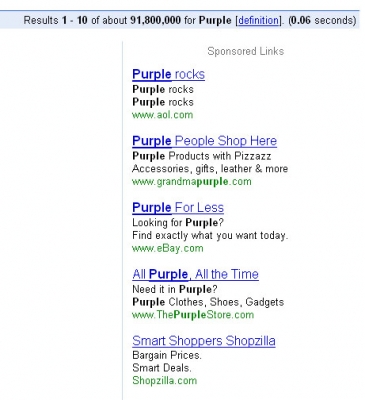
45 points
What is advertising? by Darkaardvark
April 23rd, 2007 9:57 AM
Scroll down to the bottom for the witty version
To try to sum up what advertising is in one pithy phrase would be folly, but it's safe to say that at its core, advertising encompasses most, if not all efforts to change perception. This definition may be much broader than most would think. But to solely define advertising as the corporate-sponsored, bluntly commercial ventures of the last century or so would be to ignore a vast amount of advertising that's history stretches farther back in time than many might guess.
Advertisement in nature
Biological advertisements have existed both in the human race as well as in all other species since the dawn of time. At their core, they are a way of ensuring survival. For species to thrive, they must evolve. And for them to evolve, the "strong" mutations must be passed on while the "weak" mutations are not. Some evolution is very direct- for example, weakness to a fatal disease would cease to be passed on quite quickly. But for less direct causes, the survival of the species requires that the strong characteristics are passed on- and for that to happen most effectively, two members of the species must carry the "strong" gene.
Biological advertisement is a way to ensure this. All animals are born with the instinct to seek out sexually desirable members of their species. This "advertisement" can come in many forms- from mating calls to the brightly-colored plumes of the peacock. (See image 1)
The advertisement says "See me! Mate with me!". It can be subtle or direct, but in the end, the goal is to ensure that an animal who will be able to give birth to strong, healthy offspring will have their choice of mate.
The connections to the human species are, I believe, fairly obvious.
A history of advertising
But advertisement stretches far back in history not only biologically but more deliberately as well. Advertising in human culture stretches as far as 4000 B.C. and beyond. A complete treatment of all the forms of ancient advertising would be both impossible and uninteresting.
However, one interesting example comes not in the realm of the marketplace but in the name of a country. The country is Greenland. (See image 2)
Which, upon closer inspection, is not so green after all. So how did it get its name? Around 982 A.D., Erik the Red and other settlers from Iceland began to colonize Greenland. Ironically, Iceland is often more green than Greenland. For the colony to be successful, Erik the Red knew that he had to attract settlers. And so, in one of the more interesting examples of early advertising, he named the country Greenland. Sounds nice when you just consider the word, doesn't it?
As time has moved on, advertising has become more and more direct. In the 1700 and 1800's, advertising certainly existed, but it was often restrained, whether out of a sense of moral decency or simply the fact that no one had thought to lie (or exaggerate) about their product. But by the 1950's, advertising had taken on a blunt form: Often interspersed with regular programming both on the radio and television, the message was clear and direct: Buy our product- it fills your needs and does it cheaper, faster, and better than our competitors. (See image 3)
Then, of course, we have advertising in today's world. Much has changed, and much has stayed the same. Apart from the standard TV and radio commercials, a new form of advertising is increasing in popularity while remaining somewhat unnoticed- product placement. (See images 4 and 5)
Product placement integration is becoming subtler- often blending in entirely with the TV show or video game, and of course, that is the intent. Product placement has also become a major factor in Alternate Reality Games (although, thankfully, SF0 has remained clear). The Lost Experience and the Heroe's ARG both feature sponsorship ranging form subtle to obvious from a variety of sponsors- Sprite, Jeep, Nissan, and more. (See audio clip and image 6)
Another recent innovation in advertising is the advent of "relevant" ads- a phenomenon that did affect SF0, through Google ads. Using keywords and the like, advertisers are now able to display their message to more and more specifically targeted groups. (See image 7)
What kinds of advertising are there?
So let's sum it up.
1. Biological advertising- Attempts to attract (or even repel) other animals.
2. Direct advertising- The kind of ads we're used to- Fairly blunt, often exaggerated television, radio, and print ads.
3. Logo advertising- Not exactly product placement, and not exactly direct. It's the kind of advertising companies receive when they print their logo on your t-shirt, when you see the massive golden arches outside McDonald's, or when you see that distinctive Coca-Cola vending machine.
4. Product placement advertising- When a company's products or ads are snuck into a broader context like a television storyline or a video game.
5. Directed advertising- Where technology is used to identify a specific group of people who are more likely to be interested in that form of advertising.
What is advertising?
Okay, great. We've seen a history and summarized the types of advertising. But what does all of this mean? For that, it's time to move away from the specific examples and talk in vague, undefined, deliberately-misleading platitudes. *cough* Excuse me.
I said earlier that advertising is designed to change perception. That can mean several things. One thing that advertising attempts to do is to raise awareness. An unknown product can't change a person's perceptions about that product if they don't have any, but they can inform the person of their existence. Next, advertising attempts to change positive perceptions about the competition. Campaign ads are the epitome of this, with "mudslinging" designed to blacken the opponent's image rather than actually support the candidate. And then, of course, advertising attempts to create a positive perception of whatever is being advertised. That's fairly straightforward.
What isn't straightforward about advertising is that it works in many different ways- to paraphrase the Simpsons, advertising can be subliminal, liminal, or superliminal.
Read the short version here!
Now, I know a lot of you prefer completions of the "What is" tasks with snippy one-liners. So I'll close with a few of those.
Advertising is the mind-altering drug that corporate America does want you to have.
Advertising is lies mixed with just enough truth to make it palatable.
Advertising is kicking your mind when it's down.
So, at the risk of the dread red "X", that is advertising.
To try to sum up what advertising is in one pithy phrase would be folly, but it's safe to say that at its core, advertising encompasses most, if not all efforts to change perception. This definition may be much broader than most would think. But to solely define advertising as the corporate-sponsored, bluntly commercial ventures of the last century or so would be to ignore a vast amount of advertising that's history stretches farther back in time than many might guess.
Advertisement in nature
Biological advertisements have existed both in the human race as well as in all other species since the dawn of time. At their core, they are a way of ensuring survival. For species to thrive, they must evolve. And for them to evolve, the "strong" mutations must be passed on while the "weak" mutations are not. Some evolution is very direct- for example, weakness to a fatal disease would cease to be passed on quite quickly. But for less direct causes, the survival of the species requires that the strong characteristics are passed on- and for that to happen most effectively, two members of the species must carry the "strong" gene.
Biological advertisement is a way to ensure this. All animals are born with the instinct to seek out sexually desirable members of their species. This "advertisement" can come in many forms- from mating calls to the brightly-colored plumes of the peacock. (See image 1)
The advertisement says "See me! Mate with me!". It can be subtle or direct, but in the end, the goal is to ensure that an animal who will be able to give birth to strong, healthy offspring will have their choice of mate.
The connections to the human species are, I believe, fairly obvious.
A history of advertising
But advertisement stretches far back in history not only biologically but more deliberately as well. Advertising in human culture stretches as far as 4000 B.C. and beyond. A complete treatment of all the forms of ancient advertising would be both impossible and uninteresting.
However, one interesting example comes not in the realm of the marketplace but in the name of a country. The country is Greenland. (See image 2)
Which, upon closer inspection, is not so green after all. So how did it get its name? Around 982 A.D., Erik the Red and other settlers from Iceland began to colonize Greenland. Ironically, Iceland is often more green than Greenland. For the colony to be successful, Erik the Red knew that he had to attract settlers. And so, in one of the more interesting examples of early advertising, he named the country Greenland. Sounds nice when you just consider the word, doesn't it?
As time has moved on, advertising has become more and more direct. In the 1700 and 1800's, advertising certainly existed, but it was often restrained, whether out of a sense of moral decency or simply the fact that no one had thought to lie (or exaggerate) about their product. But by the 1950's, advertising had taken on a blunt form: Often interspersed with regular programming both on the radio and television, the message was clear and direct: Buy our product- it fills your needs and does it cheaper, faster, and better than our competitors. (See image 3)
Then, of course, we have advertising in today's world. Much has changed, and much has stayed the same. Apart from the standard TV and radio commercials, a new form of advertising is increasing in popularity while remaining somewhat unnoticed- product placement. (See images 4 and 5)
Product placement integration is becoming subtler- often blending in entirely with the TV show or video game, and of course, that is the intent. Product placement has also become a major factor in Alternate Reality Games (although, thankfully, SF0 has remained clear). The Lost Experience and the Heroe's ARG both feature sponsorship ranging form subtle to obvious from a variety of sponsors- Sprite, Jeep, Nissan, and more. (See audio clip and image 6)
Another recent innovation in advertising is the advent of "relevant" ads- a phenomenon that did affect SF0, through Google ads. Using keywords and the like, advertisers are now able to display their message to more and more specifically targeted groups. (See image 7)
What kinds of advertising are there?
So let's sum it up.
1. Biological advertising- Attempts to attract (or even repel) other animals.
2. Direct advertising- The kind of ads we're used to- Fairly blunt, often exaggerated television, radio, and print ads.
3. Logo advertising- Not exactly product placement, and not exactly direct. It's the kind of advertising companies receive when they print their logo on your t-shirt, when you see the massive golden arches outside McDonald's, or when you see that distinctive Coca-Cola vending machine.
4. Product placement advertising- When a company's products or ads are snuck into a broader context like a television storyline or a video game.
5. Directed advertising- Where technology is used to identify a specific group of people who are more likely to be interested in that form of advertising.
What is advertising?
Okay, great. We've seen a history and summarized the types of advertising. But what does all of this mean? For that, it's time to move away from the specific examples and talk in vague, undefined, deliberately-misleading platitudes. *cough* Excuse me.
I said earlier that advertising is designed to change perception. That can mean several things. One thing that advertising attempts to do is to raise awareness. An unknown product can't change a person's perceptions about that product if they don't have any, but they can inform the person of their existence. Next, advertising attempts to change positive perceptions about the competition. Campaign ads are the epitome of this, with "mudslinging" designed to blacken the opponent's image rather than actually support the candidate. And then, of course, advertising attempts to create a positive perception of whatever is being advertised. That's fairly straightforward.
What isn't straightforward about advertising is that it works in many different ways- to paraphrase the Simpsons, advertising can be subliminal, liminal, or superliminal.
Read the short version here!
Now, I know a lot of you prefer completions of the "What is" tasks with snippy one-liners. So I'll close with a few of those.
Advertising is the mind-altering drug that corporate America does want you to have.
Advertising is lies mixed with just enough truth to make it palatable.
Advertising is kicking your mind when it's down.
So, at the risk of the dread red "X", that is advertising.




















.jpg)













